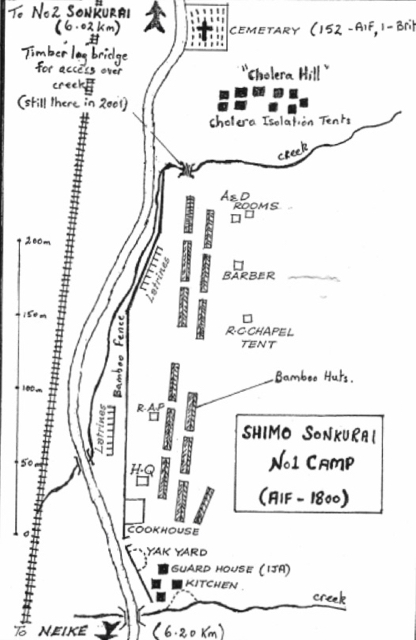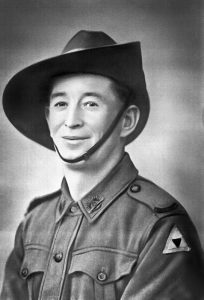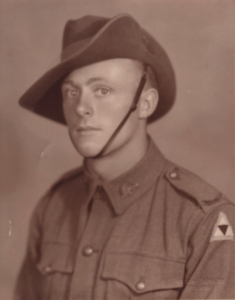Shimo Sonkurai (Lower Sonkurai) 288.10 k - Thailand
Shimo Sonkurai No. 1 Camp (Lower Sonkurai) 288.10km – Thailand
arrived beginning of monsoon season:
‘Speedo’ – POWS working 12-15 hours daily on little food
beatings were frequent
Woke in rain, muddy floored huts, left Camp in rain, walking kilometres am & pm in rain, returning to muddy camp
roads became quagmires – ration transport trucks ceased
POWs arrived back from working on the rail and then find they had to walk miles to access rice rations for their camp – Bruce Hunt changed this policy (officers should have been rostered to do this rather hang about the camp every day doing nothing but being a ‘drone’ (a ‘drone ‘was an officer who did between zero and very little for the camp)
Cholera arrived

Shimo Sonkurai Camp for most Australian POWs in ‘F’ Force was the end of a route march of approximately 290 kilometres which took between 17-20 days. Marching mostly at night, to avoid heat of days, the men were subjected to sprains, feet and leg injuries, even broken limbs due to falls down embankments where they lost shoes and belongings as they trekked mostly in total darkness (created by the tall trees and dense vegetation) on very poorly constructed tracks. Even boots fell apart.
Shimo Sonkurai was the No. 1 Construction Camp for ‘F’ Force which was made up of 3,666 Australians and the remaining British to make up a total of 7,000 men. It was the main Australian camp and this is where Lt. Col Kappe was ensconced.
17 May 1943 – Dr. Lloyd Cahill recalled ‘We had been at the new camp one day – I had diagnosed the first cholera case and the chap died. Cahill was extremely concerned as he was the only doctor and wondered how he was going to manage. Cahill was unaware a message had already been sent from Lower Neikhe to Konkoita to the senior Medical Officer to come forward. Major Bruce Hunt and Capt John Taylor would proceed to Lower Songkurai.
The next morning Hunt and Cahill innoculated 1400 men with 1/2 cc vaccine from limited stocks brought forward from Changi.
The cookhouse was 400 metres from camp, 730 metres from the main hospital and more than a kilometre from the isolation camp (cholera).
Within the next few days, 70 tents and loads of attap were delivered into the camp, and shelter from the rain and heat of the day became possible. After having spent several miserable nights in the open, the troops found the cover most welcome.
The following is from Winstanley’s Website
https://www.pows-of-japan.net/articles/102.html
‘There is no doubt that the forceful leadership displayed by Majors Johnston and Hunt were the reason Lower Sonkurai Camp eventually became the most hygienic and possessed the highest morale of any “F” Force Camp. The employment of all spare fit officers on works and hygiene was a big factor in maintaining a standard of morale that was to become an important factor in the fight for life in which nearly every member of the A.I.F. was to become involved during the next few months.’
Major Bruce Hunt with his medical team worked miracles with little support from the Japanese.
Within 7 months almost half of the 7,000 POWs had died. To begin with, approximately 1/3 of ‘F’ Force were classified sick and unable to work before setting out from Singapore.
The POWs then had been ruthlessly marched north about 290 kilometres for 17-20 days into Thailand, starved, denied medicines and mercilessly worked to death.
‘F’ Force was to remain under Singapore Administration jurisdiction and not Thailand Administration. There existed a series of petty jealousies between the two Japanese groups which resulted in ‘F’ Force men being the ones to lose out mostly by the inconsistent deliveries of essential food supplies.
On 28 July 1943 the first party departed Shimo Sonkurai to Kami (Upper) Sonkurai following the closure of the camp and evacuation of sick to Tanbaya. The party consisting of 7 officers and 295 other ranks took five hours to complete. Of the 302 men, 173 men were immediately admitted to hospital on arrival, some never left Tanbaya alive.
In addition to the four parties of about 650 men from Shimo Sonkurai to Kami Sonkurai there were approximately 310 British from Changaraya and 360 from Nikhe.
By 8 August 1943, Shimo Sonkurai totalled 1,690 men of whom 670 were British and 1,020 were Australians. Generally the British from Changaraya were in a poorer state of health than the Australians (they had suffered heavy losses from Cholera).
As the British and Australians poured into the camp they were greeted by the usual sight of roofless atap huts and less than adequate latrines. An insufficient number of Burmese had been employed to roof the huts and POWs were forced to sleep out in the open. Some sick were forced to sleep in huts where the floors were collapsing. The latrines had broken its banks and effluent was running through the camp and under the floors of the huts being used as the hospital.
Rations were at starvation level. Roads had collapsed during the monsoon. POWs had to pull ration carts over seven kilometres through thick mud. By 19 July some 1350 men of a total camp population of 1850 were sick.
Cholera Hill at Lower Sonkurai was a small collection of tents located at the northern end of the camp. Cholera which broke out 17 May reached epidemic proportions with great loss of life every day.
There were 80 Australian Officers including three medical officers – an embarrassingly large number. One officer accompanied every 50 men on work parties outside camp but did not substitute for men in working parties. Officers were employed on camp duties. Hunt introduced a scheme where officers were employed as ward masters in the camp hospital. (WX3450 Capt George Gwynne of 2/4th was ward master). Although themselves often ill, no officers died at Shimo Songkarai.
late July and early August the Japanese ordered POWs to march north to Kami Songkurai and Songkurai. There were no more than 104 fit men and 94 ‘walking patients’ plus 16 Stretcher cases in this party (three of these returned to Kami Songkari Camp Hospital where two of them died within a few hours).
500 sick POWs remained at Shimo Songkarai until late Sept – when 277 men were transported to a base hospital Camp at Thanbaya, Burma.
When the camp was finally evacuated a sign was left over the sapling- fenced cemetery at Shimo Songkari. The 2.5 m sign read ‘We Will Remember Them’.
From ‘The Men of The Line’ by Pattie Wright (P183)
I was most shocked to read 2023 an interview by Pattie Wright with Reg Jarman, Medical Orderly 2/10th Australian Field Ambulance, ‘F’ Force
Jarman was one of about 10 orderlies working with Capt. Peter Hendry, MO in charge of the cholera hospital at Sonkurai.
20 year old Jarman described himself as a ‘bushie’ (country boy).
When cholera broke out at lower Sonkurai he and another orderly Harry Williams, were asked to do a post mortem on the first two cases. Asked to take the bodies away from the sight of other patients and remove samples of the dead POW’s soft organs: liver, spleen, lungs, pancreas and kidneys and bring them back for the doctor to examine. Nobody in the hospital wards ever wore gloves or had protection because there was none.
On another occasion, Dr Hendry asked Jarman to remove the brains during another post mortem because Hendry knew Jarman was a ‘bushie’, and knew he had helped kill some of the little cattle which came into the camp. Jarman had secretly removed blood, brains and fillet to take to the sick in the hospital ward.
Jarman explained ‘A lot of men on the line were city boys and if given a shovel, they wouldn’t know how to dig a hole.’ Jarman knew how to dig a hole!
Jarman moved to Sonkurai.
War Crimes Court No. 5 Singapore – Friday 11 October 1946
Kappe returned to the witness box (he was there the previous day) and began to describe conditions at Shimo Sonkarai.
He said there were 1854 POWs at the camp:
1300 POWs in hospital
375 POWs forced to work each day
‘They marched through 5 kms of mud to work where parties of 10-12 men were forced to carry logs 15 ft long (4.5 metres) and between 10-12 inches (25 – 30 cm) in diameter a distance of one km. Men were continually collapsing – being driven along by Japanese soldiers with bamboo sticks.’
Kappe said he met a reasonable young Japanese officer (whose name he did not know) he was under CO Banno.
While under command of the young officer ‘The food was better than any other ‘F’ Force Camp. Before Fukuda arrived at the Camp, Kappe said he was able to send men to Neikhe Camp for supplies of milk and oil for sick men. During August and September under Fukoda’s command no permission was granted. Prior to Fukoda no sick men were being forced to work.
Kappe then said “the same applied in November when Fukuda left to go to Neikhe and his place was taken by a young provisional officer 2nd Lieutenant Yumamoto Minoru who had just been promoted from officer cadet. It was on his arrival that Toyoyama was completely put out of his place.”
Yumamoto was more willing to cooperate and compromise with the POWs. One of the first things he did was rein in Toyoyama.
We would like to acknowledge and thank author Robin Rowland and his book ‘A River Kwai Story’ The Sonkurai Tribunal.
Interesting that Kappe should give evidence at the War Trials – one has to ask how much he actually witnessed any of day to day Camp life? Of course he did compile a history of ‘F’ Force and 8th Division during incarceration at Changi where he would have interviewed the men and gathered information from recorded reports.
It is clearly reported the POWs did not see Kappe at Shimo Songkarai (including Sgt Keith Meakin who Kappe asked to carry and watch over his trunks) and accused him of staying in his tent.
During the Tribunal Kappe was asked by Prosecutor Backlock whether he agreed with what Colonel Hutchinson says ‘where Colonel Banno arbitrarily ordered men at random from the sick to go out to work? If you are not certain, you will naturally say so.’
‘The only supporting evidence I have is similar to the other circumstances’ replied Kappe. ‘When people gathered at Changi on their return home from Changi we enquired from each other a gathering of incidents.’
‘Yes, that is the point, you had only this summary of recollections and instances , but from your own personal knowledge you cannot say?’ asked Blacklock.
‘No.’ Kappe replied before stepping down.
Blacklock had been questioning hearsay evidence of probative value that was admitted previously, questioning the validity of such evidence. (ie evidence is hearsay if it’s probative value is not based on the personal knowledge of the witness but on the knowledge of another person who is not on the witness stand.)
Above information: P334,335 Sonkrai Tribunal by Robin Rowland.
Leaving Kami Sonkari to return to Kanchanaburi and then Singapore
The arrogance of Kappe – 17 November 1943
At this point in the book Rowland writes ‘Kappe had two large suitcases with him and assigned Sgt. Keith Meakin from his own 8th Division Signal Corps and a warrant officer to watch over them as he (Kappe) supervised the loading of the train. Meakin said he had not seen Kappe at all during his time at Kami Sonkurai prior to this encounter!
When the train finally arrived, much later than expected, there were not enough wagons to carry all the ready and waiting men. This however, this did not stop Kappe from ordering Meakin and the warrant officer to manhandle the two trunks into one of the wagons. They were so heavy it required two men to load them onto a flat car. In the end only Kappe and 50 men got on the wagon. 450 remaining men watched as the train disappeared into the blackness of the jungle while the rain began falling heavier. These men returned to their huts.
The next day, 18 November the Australians at Kami Sonkurai ‘Stood by’ all day until the Japanese told then to walk (or stagger as Sam Arneil wrote) to Sonkarai and then onto Niekhe a distance of 11 kilometres. Only 300 POWs made the journey, 150 men were left behind judged to be too ill to march the distance. Major Noel Johnston remained behind to command and care for the sick. (pages 200 and 201).
At Sonkurai
At Sonkurai where hope lay drowned
Beneath the bridge the earth is browned
With mould and monsoon vapours veil
The jungle and the creepers trail
Like snakes inert their coils unwound
And there our rear-guard kept their ground
Eight comrades laid beneath each mound
A thousand dead without avail
At Sonkurai
Freed from the captive’s weary round
Homeless, a lasting home they found
Let not our faith their courage fail
‘Til with the dawn the stars turn pale
And, silent long, our bugles sound
At Sonkurai
From COFEPOW
Those from 2/4th who died at Shimo Sonkurai include:
WX8864 GREGORY, John Edgar James of ‘F ‘Force died of cholera 1 June 1943 aged 39 years Shimo Sonkurai.

WX9073 PATERSON, William James died 25 July 1943 cerebral malaria and colitis aged 27 years, Shimo Sonkurai.
Below: Paterson and on right McIntosh.


WX9849 MCINTOSH, Archibald James Livie died 10 November 1943 beri beri and dysentery aged 23 years at Shimo Sonkurai.
